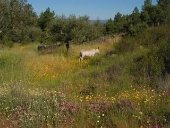Hello Dawn,
Only now have I seen your post and it's been a while since it's here. What have you done?
I also have some 300 olive trees, though in a less prone to fire region: Douro. But I totally understand fire is a main issue to you in Andalucia.
Nevertheless, I believe the underneath concern is having a profitable production. Since olive trees is generally going through the same problem a bit everywhere you, like me, is looking for different ideas to correct ways of doing. Something, or a lot of stuff, must be wrong if our land is going bare.
The olive trees produce best with "half" sun exposure, so yes, you should prune some so that most of the trees get some light going through.
We're not getting sanitary problems with the olive trees here for quite a few years which makes for one less problem: no pesticides.
We struggle with the same rainy winters and long dry summers.
We also have sheep pasturing.
Leaving tall grass or olive tree branches on the ground is really explosive for fire. Olive tree wood is very hard to burn, but once ignited will consume itself slowly igniting again very easily. Olive tree leaves are the most dangerous part: they are full of oil and burst into big flames in a second. So, if you don't get lot's of moisture, leavin branches or tall grasses is a sure path to disaster. And we had proof of it in my cousins land (though warned) where he left too much grass, turned dried in summer, and... he lost more than 500 olive trees.
My olive tree land has some slope, so we did a swale rather uphill to start collecting and retarding the water. We're about to do a second one with huggelculture more or less in the middle of the slope. We'll be filling it up with the prunnings and some manure. And we'll keep doing it if we get results we look for.
As for the sheep, they'll be out for some time. Later, for them to enter I'll have to have a talk with the sheppard. I believe he's one of the main reasons we have so little soil and wild plants. He brings the herd to pasture the plants are hardly coming off the ground. They don't have time to grow and get shopped several times each year. This treatment is worse then herbicides for them. But that's how everybody is doing here, and mabe that's why everybody has the same problems.
Also, I'll be plowing this year at least, once, on contour, so that the grooves help retain some more water. After these actions were taken I'll have to go with the flow, rethinking the situation though not expecting results in the very first year.
What have you done / is doing?








